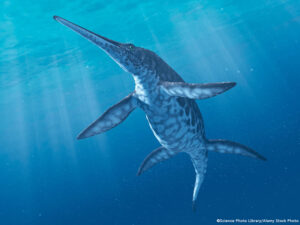Discovery of 240-Million-Year-Old Reptile Species
Two-hundred-forty-million years ago, a serpent-like creature swam the seas near southern China. Based on newly discovered fossils, scientists say the creature looked like a mythical Chinese dragon with a long neck, torpedo-shaped body, and long tail. In February 2024, an international team of scientists unveiled the entire fossilized body for the first time. The reptile is named Dinocephalosaurus orientalis, which translates to “terrible-headed reptile.”
Where It Came From
The species was identified in 2003 when a Chinese scientist uncovered a well-preserved skull and the first fossils on a farm in southern China. Since then, Professor Li Chun, a paleontologist with the Institute of Vertebrate Paleontology and Paleoanthropology in Beijing, China, discovered additional fossils of the 16-foot-long creature. Paleontology is the study of life forms in Earth’s history using fossils. A fossil is the remains of an animal or plant that has been preserved in the Earth’s crust.
The “Terrible-headed Reptile”

Li and a team of researchers from Scotland, Germany, and the United States studied the reptile’s remains for ten years. The fossils show that the Dinocephalosaurus was a long sea serpent with short, flipper-like limbs. Its neck was more than twice as long as its body with 32 separate neck vertebrae, or spinal bones. Researchers are not sure of the function of the long neck, but they believe it provided an advantage in hunting prey. Unlike other sea creatures, the Dinocephalosaurus could move its head and neck into crevices between rocks where prey might hide. Its long tail was composed of strong, flexible muscles that could drive it through the water quickly. The Dinocephalosaurus could use its powerful tail to escape a predator or catch its own prey.
The team of scientists believes the reptile lived entirely in the water. That meant the Dinocephalosaurus didn’t lay eggs on land as do some reptiles, but instead gave birth to live young in seawater. The team also discovered fossilized fish inside one of the skeletons. The most complete collection of fossilized bones shows the Dinocephalosaurus curled into a figure eight. The largest discovered skull is about 9 inches in length, and its largest preserved tooth is about an inch.
Understanding the Triassic Period
The Dinocephalosaurus is from the Triassic period. During that period, the ancestors of some modern-day reptiles—including crocodiles, lizards, and turtles—first appeared. Also, dinosaurs first existed on Earth during the Triassic period, which took place from 251 to 199 million years ago.
One of the researchers, Dr. Nick Fraser from National Museums Scotland, described the Triassic period as a weird and wonderful world with strange animals. The team published its paper describing the findings in the journal Earth and Environmental Science Transactions of the Royal Society of Edinburgh.
